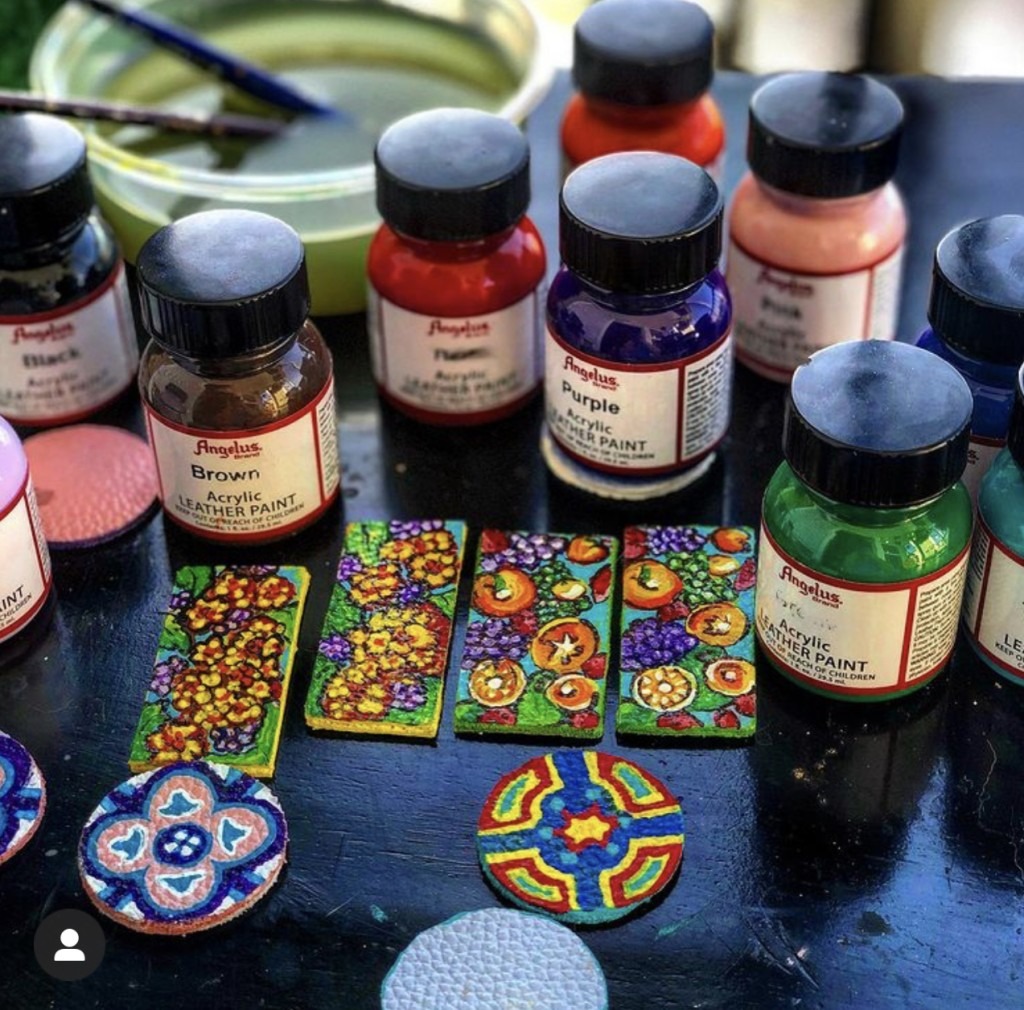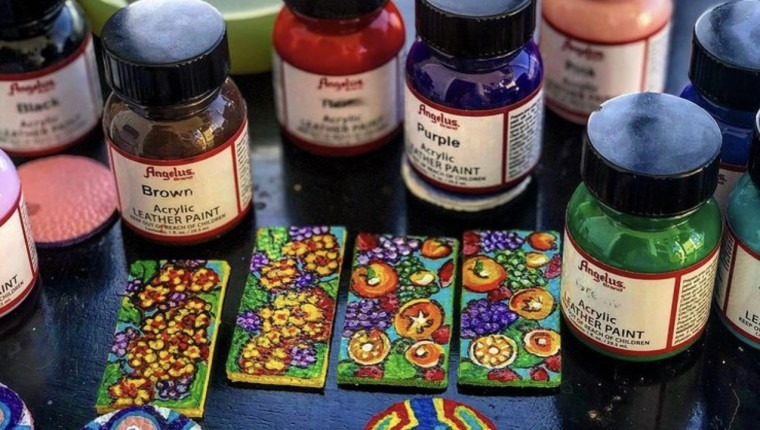Times Your Art Has Made an Impact
. . .
Creating art of any kind is personal. What you make means everything to you at that point – and it’s better not to wonder whether other folk will like it.
Performing artists and often filmmakers get instant and electric feedback from an audience. Visual artists and writers may work for years on something but not be there to see anyone’s reaction once they step away.
As a playwright, unless it’s a collaborative project here in town, the lively process of rehearsal and performance takes place at a distance, often with people I never meet. Even during times when I can travel, I’ll be there for a night or two – not for weeks of prep and then a three-week run. I’m grateful for a friendly email saying all went well, a few social media posts.
But last year, a theatre in Colorado performed Flying, about women flying military planes in WWII, as an immersive experience inside an airplane hangar. Some time after that, I got a beautiful handwritten letter from the actor who played the newly-disabled soldier in the play. Telling me how much he connected with that character, and how the story resonated with his family history. A heartfelt letter of thanks, that moved me to tears.
Sometimes the art you make does make a difference – and even if that’s to one single person, that’s enough.
We asked a range of artists to share times when they knew that their art made an impact. You can read their beautiful and powerful, and often just fun, stories here.
So if a book, a film, a song, a painting, a story in a magazine, a dance, a piece of art you treasure in your home, or pass by by on your way to work or love to see in a museum – if it’s truly special to you, look that artist up and tell them – whether it’s an email, Tweet or letter, a singing telegram or note to the museum staff.
Whether it’s an artist here in town or someone in another country who’s so famous that you figure oh, they know already – you might be surprised how few people take the time to tell artists that a specific thing they worked so hard to make has meaning to you.
But don’t be surprised how much your note will mean.
. . .
Don Gialanella
. . .
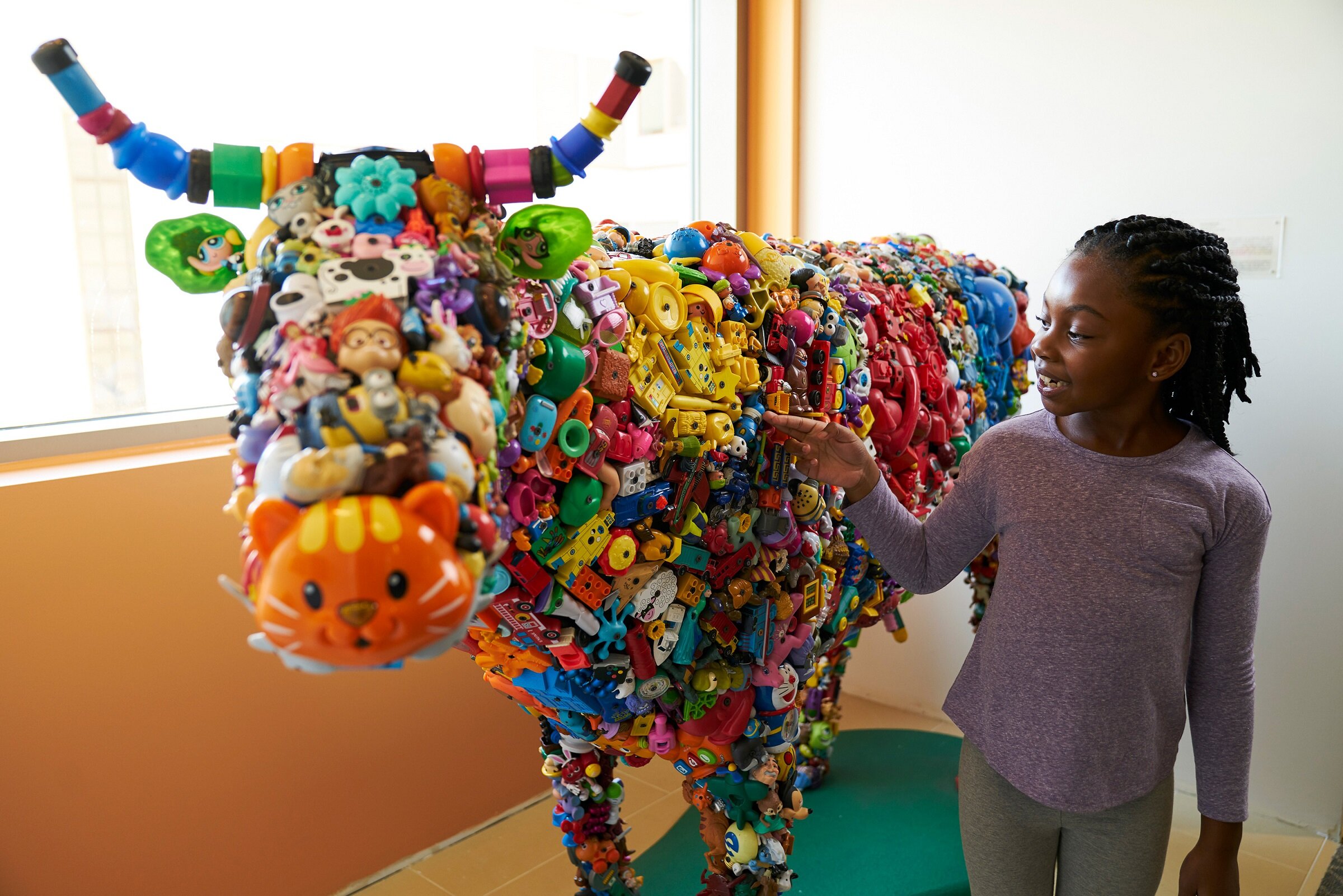
. . .
Received this touching note yesterday. Made me feel so grateful and happy that my work is helping children.
. . .
. . . . . Dear Don,
. . . . . My name is Lenore, and I work at Lucile Packard Children’s Hospital in Palo Alto.
. . . . . I walk by your sculpture of the toy cow (I think that’s its name but I’m not sure!) often, and at least once a day I see a kid standing in front of it, completely enthralled, searching up, down, and around, pointing out familiar characters… and pieces of familiar characters.
. . . . . Yesterday I heard a little boy say, “That’s Buzz Lightyear’s leg!”
. . . . . I don’t know how much you know about this hospital, but we care for the sickest kids in the country here, and many of them spend very little time outside their rooms (particularly during Covid this past year). We have a lot of wonderful art and sculpture and interactive stations all over the hospital, but I have seen more kids delighted for the longest time with your sculpture than any other single object here.
. . . . . I just wanted to say that every time I see a kid there, forgetting where they are and how they feel for a while as they hunt for Sponge Bob on the cow, it really makes me grateful for you.
. . . . . Thank you for making such a delightful piece of art.
. . . . . Cheers,
. . . . . Lenore
. . .
From afar, Toy Cow appears as a huge colorful cow sculpture. On closer examination, one sees it is made from an organized cacophony of hundreds of dolls, action figures and toys of every description. It’s as if some cosmic magnet pulled these colorful objects together to form a perfect cow. It incorporates everyday objects recombined in an extraordinary way.
The sculpture is constructed entirely of reclaimed toys permanently screwed onto an anatomically accurate wooden armature. Toy Cow makes people smile, especially children, who delight in finding their favorite toys. It provides a positive experience to aid in the healing journey.
. . .
Ketsy Ruiz
. . .

. . .
I try to collaborate with nonprofits as often as time permits. One organization I dedicate my time and art to is Batey Girls.
Batey Girls is a rehabilitation program for women and children who are survivors of human trafficking in the bateyes of Barahona, Dominican Republic.
The director, Katie Godkin, is one of the most selfless people I have ever met. With a small team over the course of several years she’s built an organization, a safe house, and storefront for Batey Girls. The women there learn how to make jewelry utilizing the larimar stone mined from the island. The jewelry is sold online, in markets and in their flagship storefront on the beach of Barahona. The women learn how to make a living for themselves and all of the proceeds go back into the organization uplifting their mission.
. . .
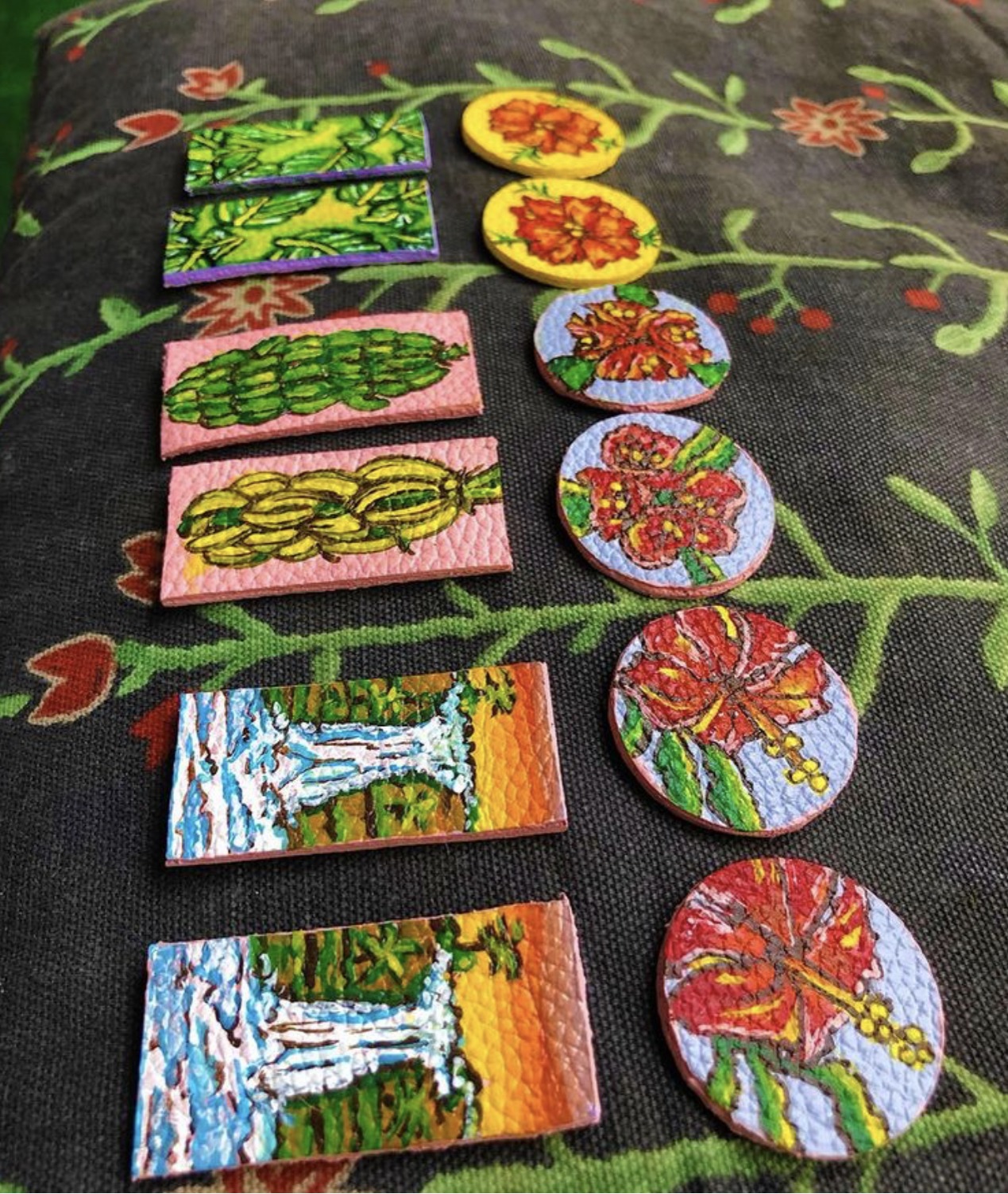
. . .
About three years ago Katie reached out and asked me if I would like to collaborate on pairs of earrings. I painted a series of Sketzii earrings on PU leather shapes that were heavily influenced by Latina culture and icons. The women in Barahona then added their beautiful larimar stones to each pair.
Most recently I was able to donate some of my Sketzii coloring books to the safe house to help foster creativity and mental health wellness.
I believe as artists and creatives we can truly make small differences in the world by just volunteering our artistic gifts whenever possible. As a brand ambassador for Batey Girls I hope to spread their message to help prevent human trafficking. To support the women and children you can visit Bateygirls.org and follow them on social media @bateygirls.
. . .
Anna Ayres
. . .
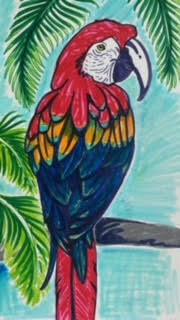
. . .
James and I sat at his family dining room table with a basket of markers and some loose sheets of drawing paper.
“What would you like to draw, James?” I said to the petit four year old next to me. “I’ll show you how to draw anything you wish,” I added, working as a nanny but now like a genie sprung from its lamp.
“I don’t want to draw.” James stated with command in his voice. Just seconds before, James had pulled the markers and paper off a shelf of haphazard toys.
“Are you sure, James? You’re such a great artist,” I encouraged. “No.”
James slunk off his chair and into the corner by his toys and began playing on his own. “Ok, no problem. I’ll be right here drawing if you need me.” While watching him out of the corner of my eye, I carried on, selecting one marker at a time to draw first a shark and then a parrot.
James stood up after a spell with his toys and looked over my shoulder. I could almost hear his shift in energy, from uncertain to curious. He sat down next to me and pulled purple from the palette of markers and began drawing on his own. Undisturbed, he eventually held his paper up to me, a squall of line and color, and exclaimed, “Look! It’s the jungle!”
“That’s beautiful, James! I’m so proud of you for drawing. How does it feel?”
“Good,” James said, almost aloof, as he reached, belly on table, for another piece of drawing paper.
A couple of years later, I received a message from James’s mother. I was no longer his nanny but Theresa let me know that around the time I cared for James, art quickly became his favorite subject in pre-school. He was a good student overall and as he grew, he excelled in art, showing great focus and confidence.
Sometimes, one tiny seed planted grows into the most fruitful tree.
. . .
Elizabeth Indianos
. . .

. . .
My recent play was the 1st Art story of the New Year – about hopefulness through Covid. Ghosts always find a way to have their voices heard… and we are hearing them now in This Blessed Plot, This Earth – just as I heard them while painting in the Tarpon Springs Cultural Center, formerly, Old City Hall, isolated and in lockdown for a year…
Hearing them, and resolved to create them and bring them to life with paint and pen and story, is a testimony of faith in our survival. Hear them speak to you in a multiplicity of disciplines, writing, music, dance, sound, art, set and costume design, drama.
There has never been in this historic City (known as Epiphany City) an Epiphany quite like this, where art and the community come together in this manner; where its histories and stories, are told by an artist, and come together as one.
. . .
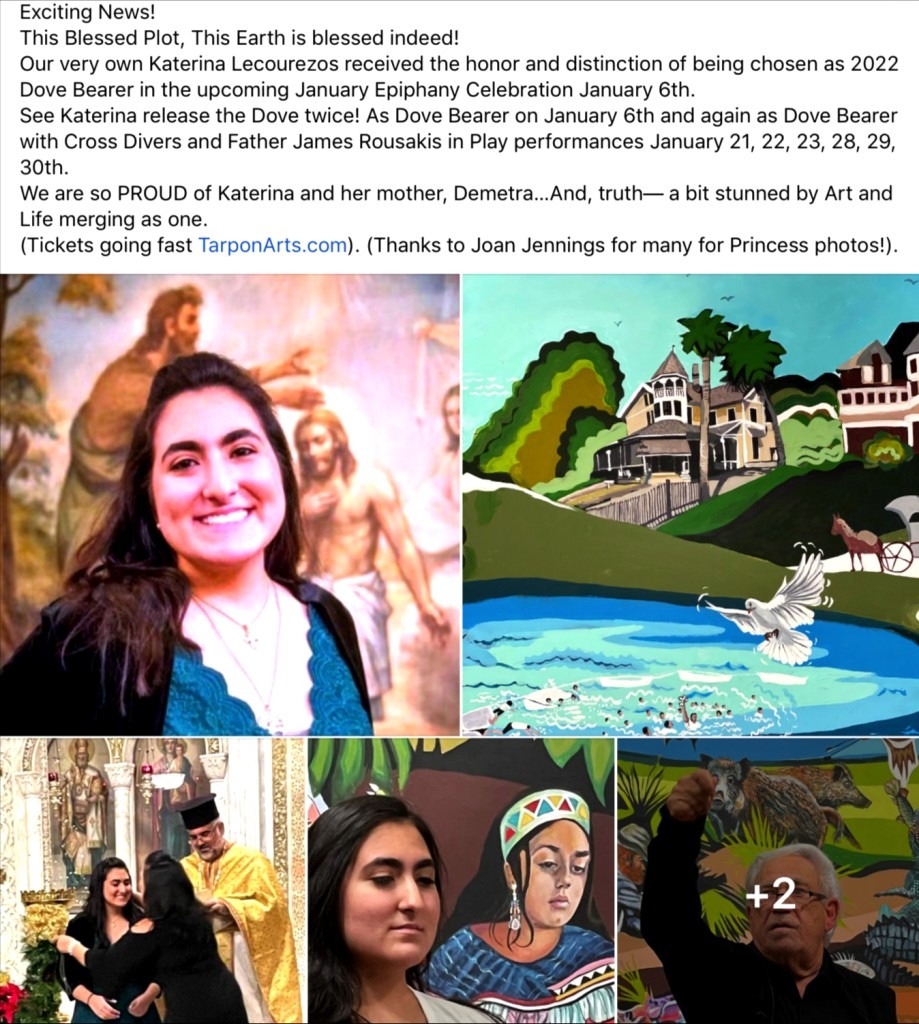
. . .
This news story has a photo of our scene in rehearsal – the Epiphany Celebration and Cross Dive, with two of the very same actors Katerina and Father James doing same scene they performed in our play on Epiphany, January 6. On that day, watching the Epiphany Celebrations at the Spring Bayou in Tarpon Springs, I witnessed a complete and unexpected nor anticipated synchronicity. The Dove Bearer in the Play was chosen as Dove Bearer in the actual ceremony. The Priest in the play, enacted the ceremony… The diver who retrieved the Cross, is the son of the Project Supervisor of the Building it all takes place in…
I’m hopeful for 2022. It seems we may be moving in the same direction as the earth turns.
. . . . .
You can read the production diaries
Elizabeth Indianos kept as this play developed
. . .
. . .
Christina Bertsos
. . .

. . .
Creating a sculpture out of stone gives me great personal satisfaction. I love working with the medium, the process of discovering its unique qualities and dreaming about what it will become.
But now add the final element of the creative process – sharing the work – and the experience takes on a whole new added dimension of satisfaction. One that not only completes the process but enhances and adds to the joy that I receive.
Each encounter I have with a person viewing my work is a very special one. I love to hear how the sculpture makes them feel and hear about their unique experiences that the piece may remind them of. Their feedback is a valuable exchange of ideas that spark further contemplation and fuel for my creativity. It’s such an important part of the experience of being an artist.
The most common question I receive is, “Can I touch the sculpture?” There is something about polished stone that seems to draw one to want to caress it. I know I do and that is one of the things I most enjoy. That’s why the surface texture is very important to me.
In addition to speaking with people about my work, I enjoy just watching their silent reaction to it. How they examine the work is something I am interested in. There was one such occasion that I fondly recall at the Arts Annual Gallery exhibition in 2020 when things were very quiet. I visited on a Saturday to see how the work was being received and explore the other wonderful art. I was in a separate gallery and looked through the doorway as a child stood in front of one of my pieces.
She looked at it and then all around her to see if anyone was watching – and touched the piece very quickly with one finger. I smiled so big as my heart lit up to that precious moment.
She knew she wasn’t supposed to touch it but couldn’t help her curiosity. It was one of the greatest compliments that I could have received.
. . .
Susana Darwin
. . .

. . .
My short film Hatboxes follows the course of a friendship between a newly divorced Orthodox woman and an out secular lesbian. The film got its first public screening at a Limmud Conference, a gathering in Chicago for learning about all things Jewish.
During the discussion after we ran the film, a woman in the audience stood up and said that Hatboxes rang true to her experiences as an Orthodox woman herself who had at one time after her marriage been in a relationship with another woman. She made a point of saying that while the film made her feel uncomfortably exposed, it really made her feel seen.
Representation matters.
. . .
Until the end of January, Creative Pinellas readers
may watch Hatboxes (18 minutes) here.
. . . . .
burmesetigertrapproductions.com
. . .
D YaeL Kelley
. . .
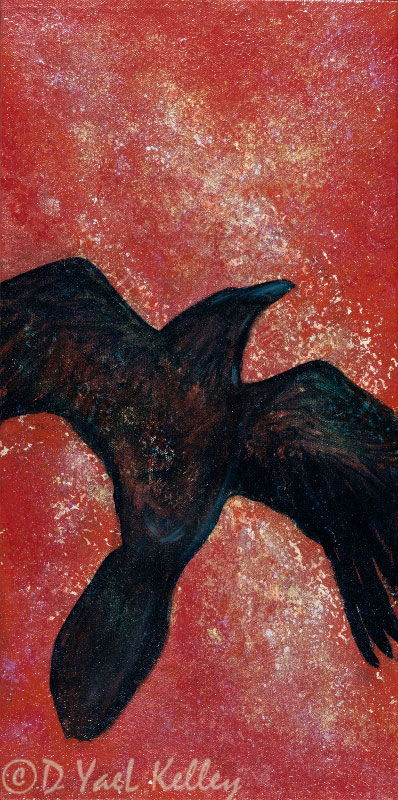
. . .
“You should be painting, it’s what you do.”
Four days before my mother went into hospital and never came home, those were the words she said. I think about the incredible gift of those words every day. Words from a mother who had for the better part of my life said things more like “when are you going to get a real job?” and “I worry about you trying to make a living like this.”
And yet when I would ask her what she wanted for the holidays it was always a painting. She bought my favorite piece at my first solo exhibition and when I said no, you can just have it, she looked sternly at me and remarked “This is your work” – and got out her checkbook.
After her death, I threw myself into my work as a way to deal with my grief. And a new way of painting came to me. Each painting a desire to communicate directly, emotionally, seeking to dissolve the barriers between our shared human states of trapped spirits inside solitary, often desperately lonely bodies. I wanted my paintings to be able to reach others, empathize, engage and comfort, heal and inspire – like the act of painting them was healing me.
Never was this more real to me than when Raven’s Flight #3 sold. I was at the opening of my show and the gallery owner brought two people over, a lovely older couple. The gallery owner said, “Tell them exactly what this painting means to you.”
I smiled because the show was full of paintings about the experience of the death of my mother and the gallery owner had earlier requested that I tone down the death and grief talk. . . so her request surprised me. I told them “when my mother died I held onto her so tightly, it was like I couldn’t move, every breath hurt, I was lost in the pain of her death until I realized that I had to let her go, that until I could do that everything that was every wonderful moment of her could not return to me.”
The couple listened so quietly and then they looked at each other and smiled, and the gentlemen said, “I have had cancer and been in and out of remission several times. Recently the cancer has returned and there won’t be a remission this time. My wife and I are preparing for this final journey. And we wanted something to put beside our bed to help us embrace this next part of our time together and our coming separation. This painting will help us do this.”
Never in all the years I had been painting did an experience touch me more deeply. Several months later the wife came into the gallery to see me. She told me her husband had passed away, that the painting had given both of them much joy and that now when she looked at it she thought of good memories and the life they had shared. That the painting represented the decision they made to embrace death and life.
I have had so many opportunities to connect on a deep emotional level with family, friends and complete strangers through my paintings. They continue to heal me and give me purpose.
I have pondered if painting is selfish – I spend so much time engaged in a solitary profession and for many years thought it unfair of me to take so much time for myself.
But these moments with other people who receive something through the work, something magical, something real, something healing, something that engages them in this world. That is the time I realize “our work makes a difference.”
. . .
Angela Warren
. . .
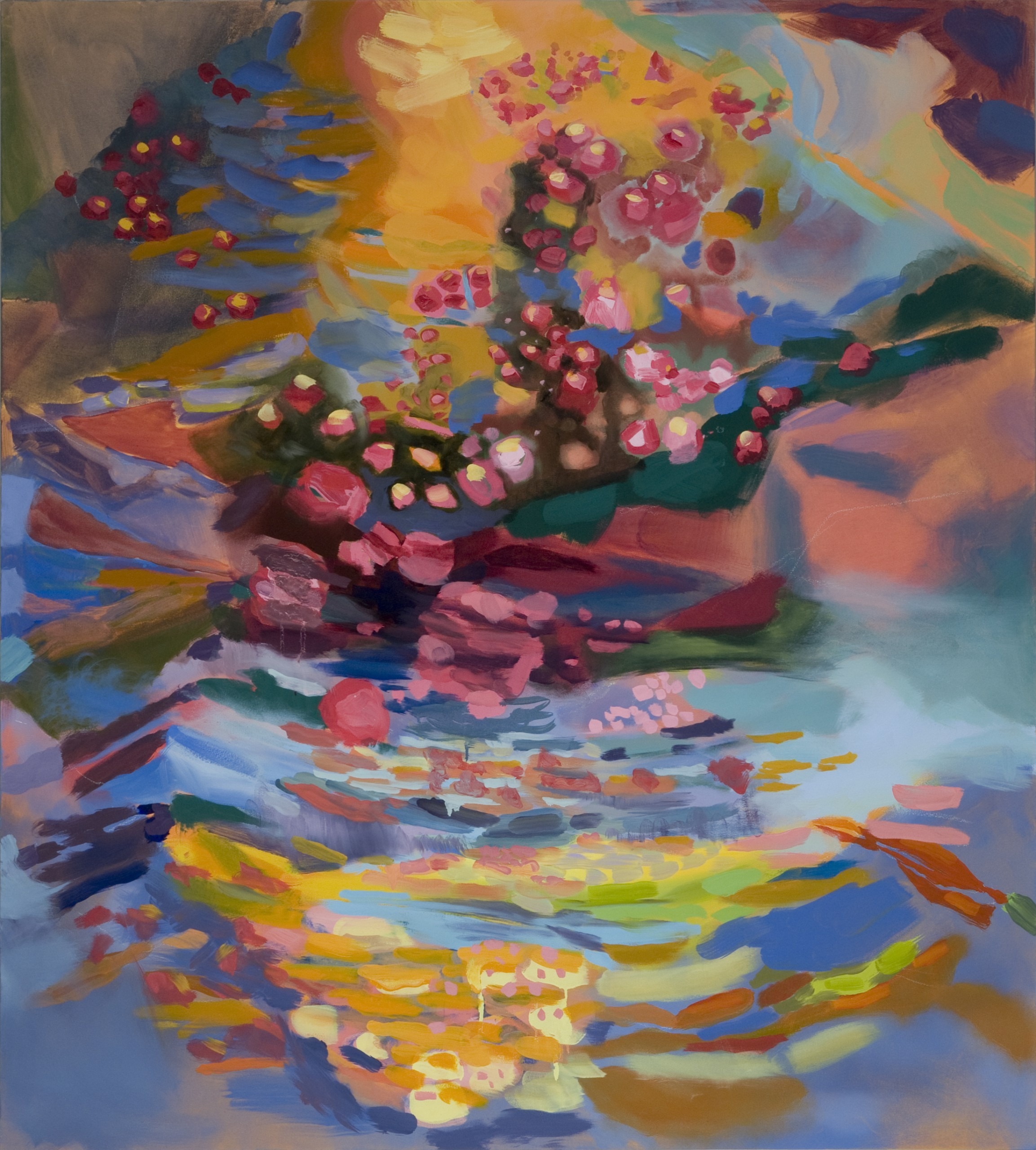
. . .
My painting Brioso is inspired by the vibrancy of nature, and music.
The title “Brioso” is an Italian musical term meaning “with brilliancy and spirit.” A music teacher asked me about the piece and said it brought her so much joy.
She loved it so much she decided to purchase it and hang it in her music room where she teaches children violin, piano and drums. She told me that she sometimes uses the painting as a teaching tool and refers to the colors, vibrancy and rhythm of the painting as a way to be inspired and play music.
She says the painting fills her home with life and all the friends and visitors that encounter it.
. . .
Teresa Mandala
. . .
. . .
For me, what keeps me going is the expression on people’s faces when someone realizes that I’ve created something that speaks to them personally.
This is a video of a commissioned piece of mine being opened as a gift.
. . .
Allen Loyd
. . .

. . .
In 2004 I designed the set for the show Otherwise Engaged by Simon Gray for the Banyan Theater.
It was a struggle with the the artistic director over concepts and budget. The props person dropped the ball and I ended up emptying my house of books and art, hauling it to Sarasota and using it to decorate the set.
I was happy with the design and invited my father and stepmother for opening night. We were seated by chance directly behind the artistic director.
The curtain went up – and the audience clapped when the lights when up on the empty set, before the first actor entered. It was my first pure set design ovation. Artistic director turned around and said congrats.
The applause made the struggle to bring my vision to the stage very much worthwhile!
. . .
Rose Marie Prins
. . .
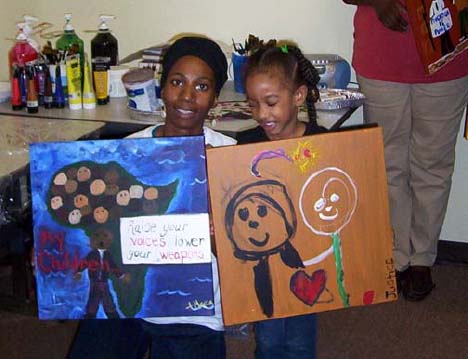
. . .
Rose Marie Prins shares her experience creating art with elementary school children, with children in hospitals, working with incarcerated youth (including one young actor who asked for his release to be delayed until after the performance!) and with communities exploring issues of stereotyping and race.
. . .
. . .
She recently gave an online talk at Dunedin Fine Art Center that you can watch here.
You can find out more about the Creative Care
arts in healthcare program at creativeclay.org/creative-care
. . .
Bob Barancik and Amy Blake
. . .
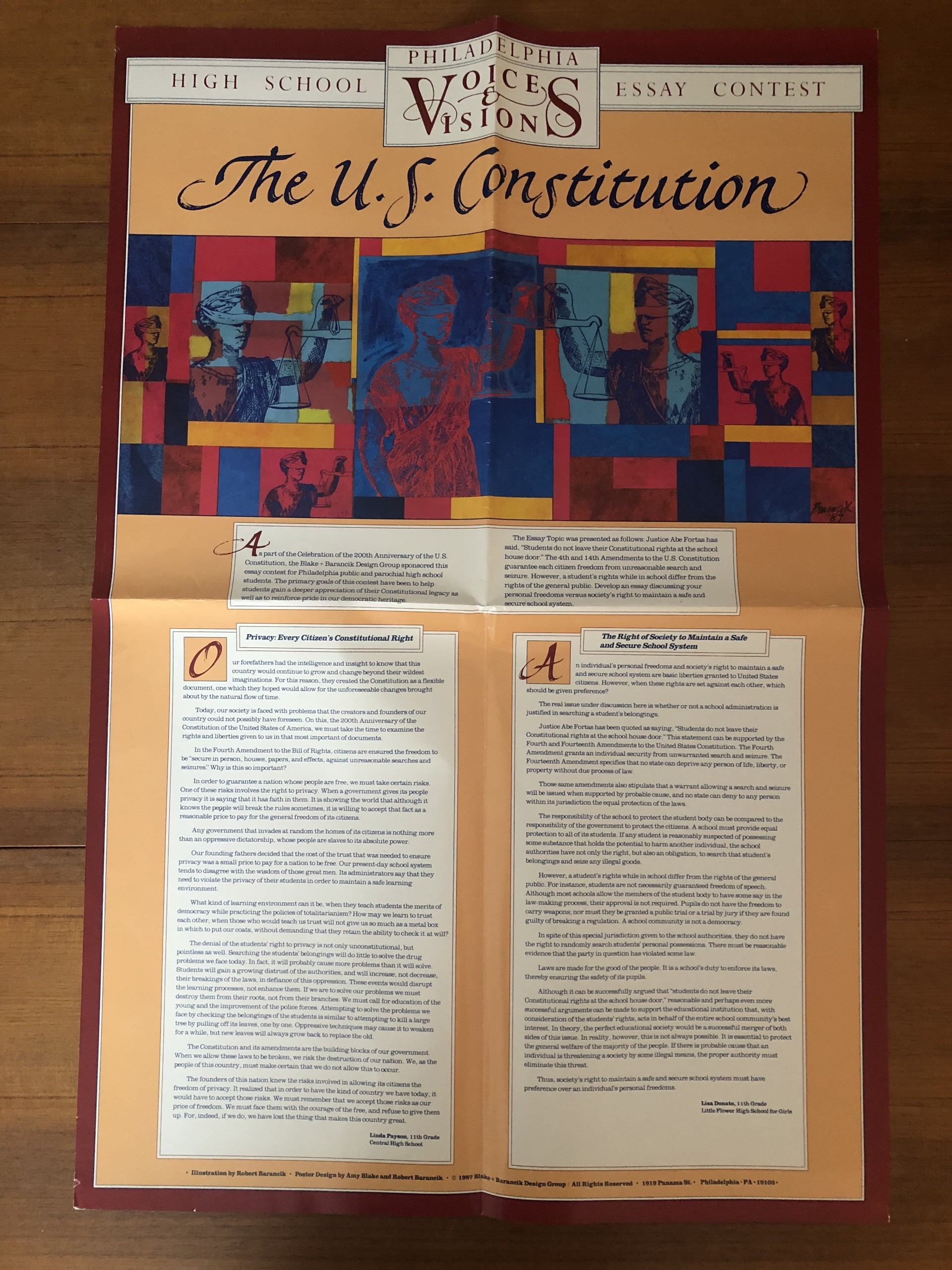
. . .
My wife, Amy Blake, and I moved from Manhattan to Philadelphia on Memorial Day 1983. We hoped to have a child and a more balanced life in the “City of Brotherly Love.” Even back then, the Big Apple was too pricey, crowded and hectic for most young creative professionals who craved family life.
In the early 1980s, Philly was a leafy, quiet, erudite and inexpensive city with deep roots in both fine arts and music. It was overshadowed by New York and suffered from a real inferiority complex.
Our new community was very traditional and ossified in many ways. We were told by insiders in the design community that it would take us about 12 years for established businesses and institutions to notice and hire us.
As ambitious 30-somethings, we needed to find a way for the power brokers to see us as a creative couple who can get things done within the existing order of things. By 1987, there was a baby daughter and mortgage payments in the picture.
I hit on the idea of a U.S. Constitution essay contest for high school students. Even nearly four decades ago, it was obvious that there was a deep divide between politically liberal and conservative polarities in the country — especially in the birthplace of our democracy. Constitution Hall and the Liberty Bell loomed large in the local consciousness.
Like every new endeavor, there were unexpected hurdles and hassles, and many pitfalls — but Amy and I persevered and made it happen. The following words are from the well-received commemorative poster that we designed. . .
“As part of the Celebration of the 200th Anniversary of the U.S. Constitution, the Blake+Barancik Design Group sponsored this essay contest for Philadelphia public and private high school students. The primary goals of this contest have been to help students gain a deeper appreciation of their Constitutional legacy to reinforce pride in our democratic heritage.”
The Essay Topic was presented as follows – “Justice Abe Fortas said, ‘Students do not leave their Constitutional rights at the school door.’ The 4th and 14th Amendments to the constitution guarantee each citizen freedom from unreasonable search and seizure. However, a student’s rights while in school differ from the rights of the general public. Develop an essay discussing your personal freedoms versus society’s right to maintain a safe and secure school system.”
Over the last decade in America, there have been 180 school shootings with 356 victims. The issues around law and order and personal freedoms are as relevant now as they were nearly 40 years ago. Perhaps more so.
Over 35 young people submitted well-reasoned and carefully edited essays (not Tweets or Facebook posts) to our contest.
Did it make a big difference (or any difference) in the lives of these students? Are they active and constructive members of their community?
Amy and I do not really know. But we are glad that we tried to do our part, and are content with that.
. . .
Katie Deits
. . .

. . .
In 2020, in response to the murder of George Floyd, I created a life-size painting of the scene. It was shown in a Florida CraftArt exhibition that year entitled, Artists as Activists. It was also exhibited at the Florida State Fair in 2021 but it was banned from the show as some people objected to it.
I hope that my artwork creates awareness and social change. Here is my artist’s statement about the piece, The Awakening of America.
Americans have had an awakening by eye-witnessing the murder of George Floyd on our phones and on the news. We viewed it often on small screens.
I created this life-size image to magnify the reality of the wrongful murder, the panic in George Floyd’s eyes and the intensity of the police officers intent on punishment.
For hundreds of years, Black people have been brutally lynched, hung from trees and asphyxiated. Today, a Black man is more likely to be killed by the police. (Shockingly three times more often than white men.) Four police officers were involved in the murder and not one stopped the asphyxiation – the lynching of George Floyd.
These injustices must stop. I hope that this artwork will create more awareness, empathy, activism and anti-racism.
Today, we are offered an opportunity to correct centuries-long wrongs – let’s do it!
. . .
Neverne Covington
. . .
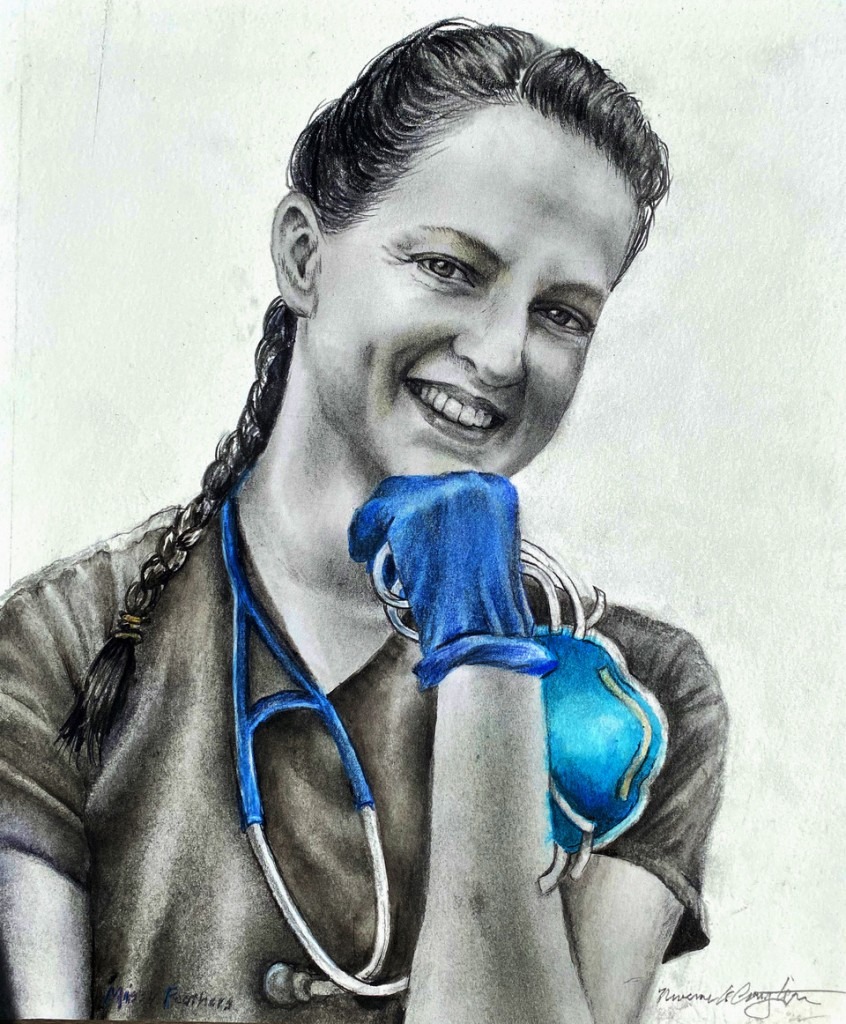
. . .
This project is now traveling throughout the state of Florida. It started in 2020 through interviews with these two people – one who saved my vision and the charge nurse of the Covid unit of Saint Anthony’s.
This portrait project consists of a series of 36 10×12 paintings of women who are crucial to making our community thrive and function. It includes women in a broad spectrum of economic status and a variety of occupations.
The purpose of this project is to honor and celebrate 2020 women’s suffrage and to honor the women of St. Petersburg who are crucial to the city’s operation.
This exhibit is part of the national organization of the Women’s Caucus for Art, St. Petersburg’s Chapter. The exhibit opened on August 8 at the Morean Arts Center, with plans for the exhibit to travel to other venues.
I chose two women to paint. The first person drawn and painted here is Missy York, charge nurse of the Covid Unit at St. Anthony’s Hospital. All of the interview questions were the same for each of the participants.
. . .
Q. Who are you?
A. My name is Missy York. I am a conservative bohemian, funny, truthful and fabulous.
Q. What do you do?
A. I am charge nurse on a COVID unit.
Q. What is your wisdom to share?
A. If we shift the paradigm to education as supreme, that one day our leaders will be grounded by science and elevated by art. We will be curious and empathetic of others and see people by their deeds and not their demographics. And we will no longer be afraid to weave our individuality with the collective consciousness of our community and life at-large.
Q. If you could do one thing for St. Pete?
A. I would completely overhaul our public school system where families do not have to “play the lottery“ to get their child in a quality school. Every school should be exemplary to generate intelligent and compassionate citizens.
Q. Comment on women’s suffrage.
A. Woman’s right to vote is her right to be heard. It is essential, that when you elect to use your voice you do so with clarity, conviction and grace for your audience.
. . .

. . .
Q. Who are you?
A. I am Nancy Diane Yates Bryant, MD. I am a wife, mother, grandmother and native Floridian.
Q. What do you do?
A. I am an Ophthalmologist in St. Petersburg who specializes in the medical and surgical treatment of eye diseases.
Q. Words of wisdom
A. Always lead with your heart – however in the words of my dear mother, Mrs. Hattie King Yates, “Always use your head!” “When we do the best we can we never know what miracle is wrought in our life or in the life of another” – Helen Keller.
Q. What one thing you would do to change St. Petersburg?
A. I would ask all people who enjoy the privilege to live and work in our beautiful city to treat each other with sincere kindness, love and respect. To become the best they can be by educating themselves, participating in healthy activities, helping and inspiring others so that collectively our city will continue to soar.
Q. Comments about Women’s Suffrage
A. The right for women to vote was gained in 1920. Sadly, that movement did not include all women due to discrimination and systemic racism. This unfortunately also included the highly educated, distinguished and accomplished women in my own family who were denied simply based on the color of their skin. Black women did not officially participate in the voting process until the passage of the Voters Right Act in 1965. Although the history of the Suffrage movement is wrought with a dramatically flawed and imperfect vision, we have seen the power of the women’s vote in our present American democracy.
nevernecovington.com
. . .
